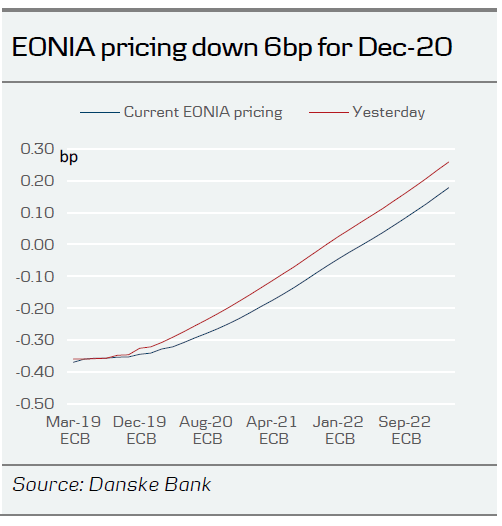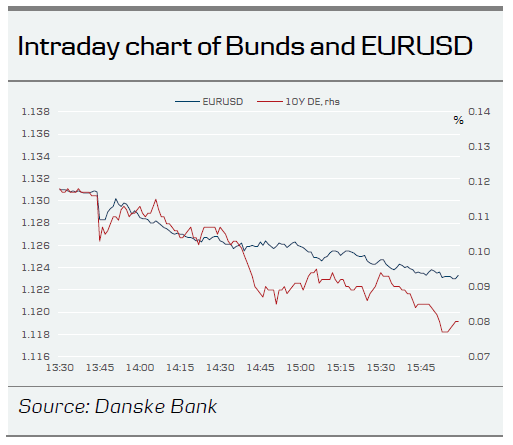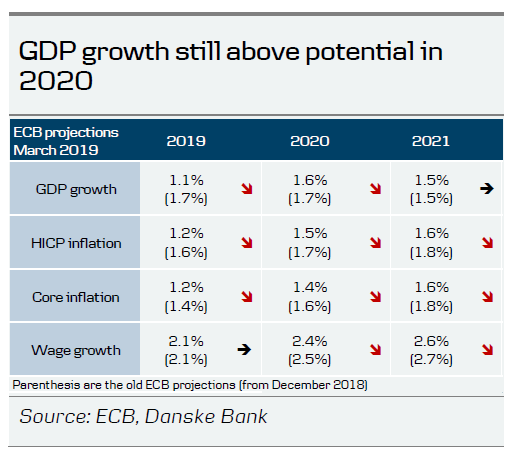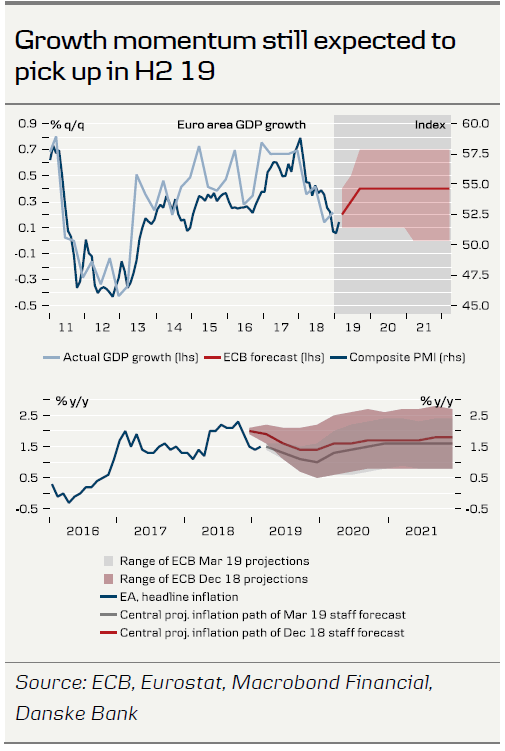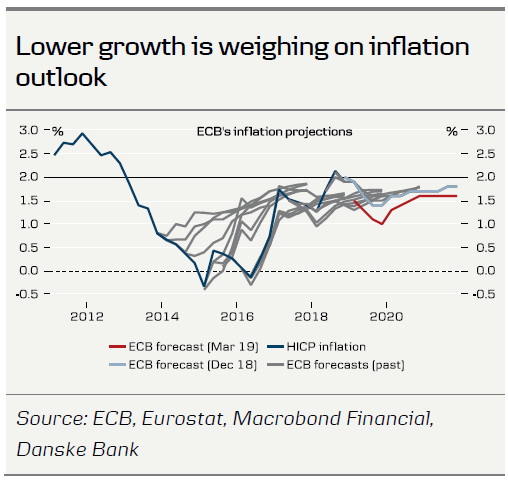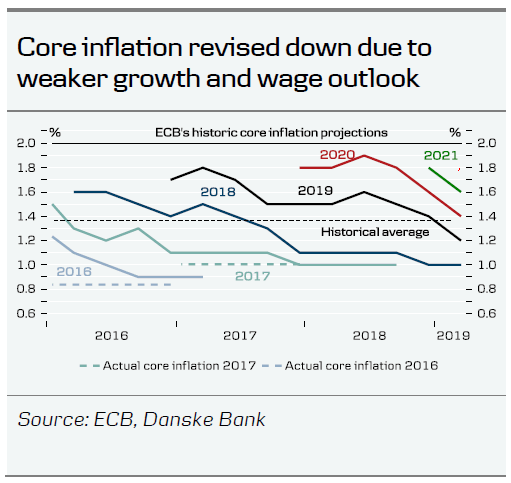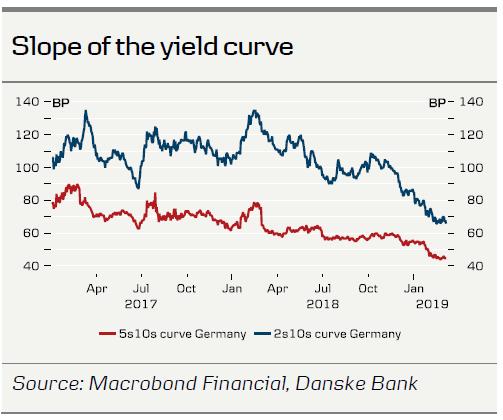- Today, the ECB surprised us by announcing a series of TLTRO3 starting in September 2019 and continuing until March 2021, each with a two-year maturity. The ECB further extended the rate forward guidance to rates remaining at present levels ‘at least through the end of the 2019’.
- The ECB was less convinced by its previous narrative and opened the door for further easing. The market responded dovishly to the downbeat signals as the ECB opened the door for further easing.
- Consequently, we change our interest rate expectations and forecast no interest rate changes to either of the ECB’s key interest rates within our forecast horizon of the next 12 months.
Tightening may not be the next move
Mario Draghi was surprisingly soft, a sign of worry that the recent slowdown is of a more structural than temporary nature. Draghi stressed that the TLTRO announcement was part of an accommodating monetary policy stance and that all tools were available. He made it clear that the package today was an easing bias. With the recent move, we do see similarities to the Japanese monetary policy stimuli agenda in the past decade.
However, we think the ECB’s projections brought an ambiguous message, which is somewhat at odds with the surprisingly dovish policy message and actions announced. The ECB expects the euro area expansion pace to slow but with momentum still recovering some ground towards end-2019. Although the ECB cut its core inflation forecasts, its overall inflation confidence remains alive and the Governing Council still judges the risk of a euro area recession and deanchoring of inflation expectations as very low. Our growth new tracker comes to the same conclusion. See more in Euro Area Research – Is the euro area heading for recession?, 4 March.
TLTRO – Italy set to be the main beneficiary
The ECB announced a series of seven operations, with a quarterly frequency starting in September this year (and ending in March 2021), all with two-year maturity. It is yet to publish the detailed modalities and will publish these in due course. However, the operations will be linked to lending requirements as in TLTRO1 and TLTRO 2. The rate will be indexed to the MRO prevailing during the life of the operation. Further, the decision points to favourable lending terms, which could indicate an MRO or down to deposit rate. However, this is too early to judge. Lending is set at 30% of the eligible loan stock. In ECB Research – TLTRO3: Italy to be main beneficiary, 9 November 2018, we pointed to the maximum additional liquidity being EUR1trn. However, it is likely to be much less, as core banks may not take as much as they can.
With the announcement of TLTRO, it also means that excess liquidity will remain abundant until well into the new decade (likely 2023), while Draghi has opened the possibility of the new president changing the rates should this be warranted. The favourable liquidity conditions are set to prevail well into 2023.
Staff projections: an ambiguous message
As Draghi outlined during the press conference, the significant downward revision in the growth and inflation outlook were an important factor behind the announcement of new measures during the meeting, as the ECB felt an urge to react to the slowdown. However, the ECB’s narrative on the macroeconomic outlook remains surprisingly unchanged compared with its previous communication.
Particularly on the growth front, the updated projections showed marked downward revisions, with growth in 2019 (1.1%) significantly below the potential level (1.5%). The ECB acknowledged that incoming data continued to be weaker than expected, weighing on the near-term outlook but, importantly, it still expects growth rates to pick up towards the end of the year and sees growth at 1.6% back above potential in 2020, on the back of favourable financing conditions and a strong labour market. Risks to the growth outlook are still seen as skewed on the downside, not least due to pervasive uncertainties leaving their mark on economic sentiment. Interestingly, the ECB projections do not take into account a possible US-China trade deal, so one could argue there remain upside risks to the ECB’s gloomy near-term growth outlook.
In line with our expectations, the growth downward revision also left its mark on the (core) inflation outlook, which was lowered by 0.2% across the years (see table). Despite this, the ECB’s overall inflation narrative was not much changed. Draghi acknowledged that core inflation has remained muted but stressed that wage growth remains strong with dispersion of nominal wage growth rates across countries at historical lows. Patience remains the mantra about the transmission from wages to consumer prices.
FX: ECB introduces ‘easing risk premium’ on EUR
The ECB clearly took our EUR call by surprise today as the expectation of a 2019 hike was a key pillar for our bullish EUR/USD view this year. In light of the very soft ECB message, the fall in EUR/USD from just above the 1.13 mark before the announcement to briefly below 1.1250 was not as large as this significantly dovish package warrants in our view. Indeed, we would expect to see the cross slide further in coming days.
We have previously stressed that prospects for the end of ECB-Fed policy divergence this year held the potential for a sustained uptick in EUR/USD towards the end of the year, i.e. that an end to Fed hikes, a US-China trade deal and a first ECB hike would, in combination, take the cross towards 1.25 in 12M. The latter driver is now effectively taken out of the equation, with this not in sight on a 12M horizon. Indeed, the ECB’s communication today highlights that all policy options are back on the table and – crucially for the FX market – this opens up the range of possible policy outcomes and introduces an ‘ECB easing risk premium’. Importantly, it also postpones the potential for a capital-flow reversal to support EUR, as negative rates will rein in the eurozone for some time still. This said, valuation still holds a hand under EUR/USD and a US-China trade deal with positive spillover to Europe remains a medium-term positive.
Near term, we expect EUR/USD to drift below the 1.12 mark – watch out for 1.1216 (2018 low) resistance and 1.1179 (27-Jun-17 low) thereafter. With the risk of pockets of USD strength from renewed pricing of Fed hikes and a trade deal that will not provide much imminent support, this opens the possibility for a EUR/USD move towards 1.10 on a 3M horizon. Over the medium term (3-6M out), we expect EUR/USD to stabilise and move back into the 1.12-1.16 range and stress that any drift higher will be limited, with any upside deriving mainly from positive spillover to the euro area from a turn in the global (China) cycle.
FI: 10Y German bunds heading to negative territory
The new TLTROs combined with the new extended forward guidance and the message that the ECB stands ready (Draghi underlined the easing bias at the press conference) to do more if necessary is very positive for market sentiment. The hunt for yield and carry is on.
Italy is the main beneficiary of the new TLTRO. In addition, the new outright yield levels that have pushed 10Y Spain towards 1% and 10Y France below 0.50% are pushing carry investors towards Italy. Given the clear easing bias from Draghi, we believe the carry game will continue for the next couple of months and even though the 5Y periphery rallied strongly today, this is still our favourite segment of the both the BTP and SPGB curve.
In respect of the German curve, we believe both the 2s10s and 5s10s curves will continue to flatten. We also believe that we are heading for a sub-zero level for 10Y bund yields and our expected trading range for the next two months is -15 to 10bp.




